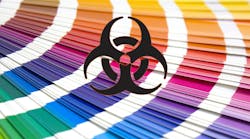With the worldwide coronavirus top of mind, scientists continue to develop new technology that can provide evidence-based guidance to quickly and accurately pinpoint potential environmental dangers.
In a study published in Advanced Science, scientists at Gwangju Institute of Science and Technology, Korea, are homing in on colorimetric sensors to intuitively reveal information about their environment through color changes.
In essence, the scientists found that combining a colorimetric sensor made up of M-13 bacteriophages with a highly lossy ultra-thin resonance promoter layer can improve the ability to detect chemicals at very low concentrations. These devices are especially attractive for their facility to detect the presence of harmful compounds, including airborne environmental pollutants.
The scientists point out that existing colorimetric sensors require complex structures with intricate fabrication procedures, and have slow response times and unsaturated colors. Instead, they developed a new version of the colorimetric sensor that’s made up of a thin layer of viruses known as M-13 bacteriophages. The scientists selected this nanometer-sized filamentous virus as a sensing layer because it can change color in response to changes in the environment.
Prof. Young Min Song, who led the study, described the M‐13 bacteriophages as being a dynamically responsive virus. “By using a highly lossy resonant promoter (HLRP) as the substrate, the spin‐coated M‐13 virus layer exhibits strong resonance even with ultrathin thickness variations, resulting in colorimetric behavior with enhanced chromaticity,” Song and his colleagues wrote. The engineered colorimetric indicator was designed with separate insensitive/sensitive areas, which revealed hidden patterns at high humidity, allowing intuitive perception of environmental changes.
“Considering the complex refractive index changes, the responsive chromaticity was improved by optimizing the resonance area for the HLRP design, and wide chromatic responsivity was verified by performing the optimization process for various material combinations,” noted the scientists.
The sensors were tested against environmental variables, such as changes in humidity, and were exposed to various volatile organic chemicals and endocrine disrupting chemicals. The scientists reported that the new design of the colorimetric sensor enables the detection of chemicals at concentrations as low as tens of parts per billion.
The scientists project that with further research the adapted design of the colorimetric sensor will prove effective and scalable for a variety of real-world applications, including industrial and clinical settings. In particular, they stated it can be used in hazardous substance detection or assessing air quality.


